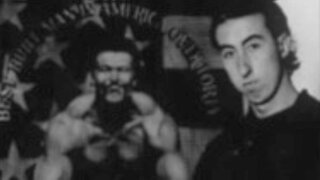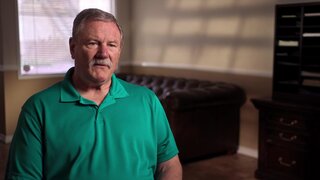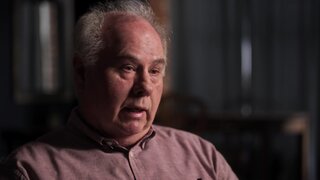Machine-Gun Murder Of Strip-Club Kingpin Went Cold For A Decade — But Then Came A Shocking Confession
The slaying of topless-bar mogul Horace McKenna left him riddled with bullets and investigators with a cold case.
On March 9, 1989, Horace J. McKenna, 46, a strip-joint kingpin and ex-CHP motorcycle officer, was mowed down by machine-gun fire as he waited in his chauffeured limousine to go through the gate to his Brea, California hilltop home.
When responding to the fatal ambush in northern Orange County, authorities were astonished to find more than 30 bullet casings lying in the driveway outside the entrance.
More shocks awaited inside the gate. Officers discovered a weird and wild menagerie that included a tiger, a jaguar, and an alligator inside the sprawling estate owned by McKenna, who was known to his friends — as well as his enemies — as Big Mac. And for good reason. His personality was just as big as his strapping 6-foot-6 frame.
It didn’t take long for investigators to learn that the victim had no shortage of adversaries, according to Oxygen's “The Real Murders of Orange County." But it would take more than a decade to find out the truth behind the deadly hail of bullets and to bring the trio of conspirators responsible for the slaying to justice.
As authorities worked the case, they began by looking at possible motives for the murder. McKenna’s son, Michael, drew early suspicion. As the heir to his father’s fortune and seedy-but-lucrative strip clubs, he was in line to benefit from an early inheritance.
But authorities soon removed Michael from the list of suspects. He wasn’t even fully aware of McKenna's businesses or his associates, and past scrapes with the law and a rap sheet prevented McKenna from having his name listed as the legal owner of his properties.
McKenna was actually the silent partner in a business arrangement with Mike Woods, a mousey man with whom McKenna shared a long history, detectives learned.
They determined Michael didn’t have motive to kill his father and moved on.
In the meantime, authorities dug deeper to get a clearer picture of who McKenna was, what made him tick, and the kinds of people in his inner circle.
A profile of a loving son whose dying words were a message to his mom and dad as well as a man who rigorously worked both sides of the law came into focus.
In the late 1960s, McKenna became a motorcycle-riding member of the California Highway Patrol, whizzing along Sunset Boulevard and keeping the streets of Los Angeles safer. Woods was his CHP partner.
But in the ‘70s, McKenna ran afoul the law. In 1976, he was arrested for allegedly running a prostitution ring. The same year he was convicted of passing counterfeit money and spent four years in federal prison, according to a 2001 Los Angeles Times report.
As a result of these offenses and others, he couldn’t hold the title of the strip clubs that were making him rich. Possible links to arson and club turf wars added to the complexities of McKenna’s profile.
Authorities looked for clues during McKenna’s graveside funeral, which drew a large, clamoring crowd. Glaringly absent from the event was Woods, the deceased’s partner.
That failed to pass the sniff test of investigators, who learned that there were years of friction between the nude- and topless-bar business partners. McKenna wasn’t afraid to bully or even “bitch-slap” Woods, according to “RMOC.”
David Amos, Woods’ bodyguard whose role in the businesses expanded exponentially following McKenna’s murder, also came under the suspicion of authorities.
But a lack of evidence to tie either Woods or Amos to the murder brought the investigation to a standstill. The case had gone cold.
The main suspects, Woods, and Amos, meanwhile, went about their business. They even collaborated on the 1994 movie, “The Takeover,” which followed drug lords in a fight for control. Woods is credited as a producer, while Amos played a key acting role.
“There’s nothing good about these fellas,” was the film’s tagline. The eerie echoes of fictional on-screen turf wars and real-life turf rivalries that were part of the world that McKenna, Woods, and Amos inhabited were unmistakable.
Still, investigators remained stymied. They couldn’t catch a break that would crack the case.
Then, that break shockingly came when the gunman, wracked by a guilty conscience, actually walked up to authorities in February 2000, the Los Angeles Times reported in 2001. It took that long for Johnny Sheridan, a low-level strip-club employee in 1989, to be ready to spill the truth about his role in the killing as well as the people who paid him to assassinate McKenna.
Sheridan was no ordinary topless bar worker. In 1987, he was arrested and became a confidential informant, Capt. Curt Rothschiller, a retired undercover detective for Ventura County Sheriff’s Narcotics Department, told “The Real Murders of Orange County.”
Sheridan told Rothschiller he killed McKenna as a contract hit. Woods paid Amos to arrange the hit, and Sheridan pulled the trigger. After the slaying, he threw the Uzi machine gun in the harbor.
Eleven years later, he was now ready to throw the men who hired the hit under the bus. Sheridan agreed to wear a wire to implicate Amos, who spilled the evidence lawyers needed to charge him in the death of McKenna.
The case wasn’t over yet, though. Amos later turned on Woods. A prosecutor secretly listened in as Amos asked Woods a question that would be potentially incriminating.
“If I take the fall for you, what are you going to do? […] Are you going to look after my family?” Amos asked Woods.
“Yes, Dave,” Woods replied.
It was all on tape.
The three conspirators were arrested in October 2000. In September 2001, Woods, 59, was convicted of first-degree murder and sentenced to 25 years to life in prison. Both Amos and Sheridan pleaded guilty to voluntary manslaughter and were sentenced to 20 years in prison for their roles in the crime.
To learn more about the case, watch “The Real Murders of Orange County” on Oxygen.com.
























